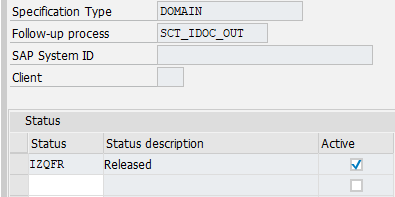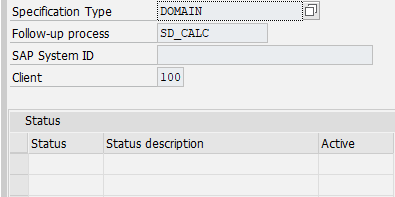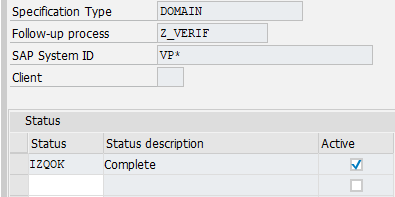Creation of a follow-up process
In addition to the standard QPPD follow-up processes, one or more individual follow-up processes (customer processes) can be created.
Necessary steps
First, an ABAP class is created. This is described in the following section Follow-Up-Processes (P).
The individual follow-up processes can be assigned to an object at the level of specification types and item types in the Follow-up processes sub-dialog. In addition, one or more statuses can optionally be assigned to a follow-up process.
If no status is defined, the follow-up process is always started.
If one or more statuses are defined, the node must be in one of these statuses for the follow-up process to be started.
An object can only be saved if changes have been made. Therefore, a save does not necessarily trigger a follow-up process.
A follow-up process can be assigned to a specification type/item type per system and client. However, the system and client details are not mandatory fields. Therefore, the following four possibilities arise:
Neither system nor client specified: The follow-up process is valid for all systems and all clients.
Either system or client specified: The follow-up process is valid only for the system or only for the client on all systems.
System and client specified: The follow-up process is only valid for the system/client combination.
Example
The distribution of the object via the QPPD IDOC should always take place for all systems.
The follow-up process SD_CALC should only be started in the 100 clients.
The follow-up process Z_VERIF should only run on the production systems.
The following figure illustrates exemplary entries for the specification type DOMAIN:
For example, the object is to be distributed via the QPPD IDOC only in the Released status. Therefore, a corresponding entry is created in the Status subdialog. The following image shows this entry:
The follow-up process SD_CALC, on the other hand, is to be started independently of the status. Therefore, there are no entries in the associated Status subdialog. The following figure shows the sub dialog:
The follow-up process Z_VERIF should only run in the Complete status. Therefore, there is an entry for the status IZQOK in the subdialog. The following figure shows the sub dialog:



